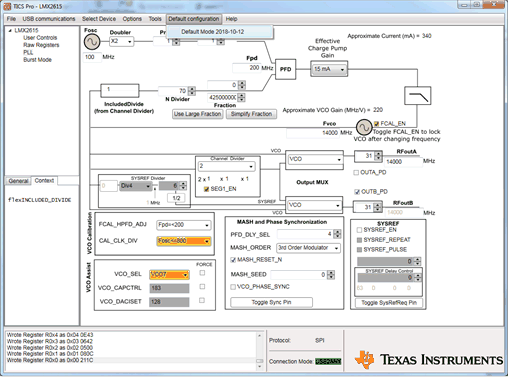SNAU218A November 2018 – August 2022
- LMX2615EVM-CVAL Wideband 15-GHz Synthesizer
- Trademarks
- 1 Evaluation Board Setup and Description
- 2 Setting Up the Software
- 3 Bringing LMX2615 to a Lock State
- 4 Current Loop Filter Configuration
- 5 Typical Phase Noise
- 6 Schematic
- 7 Bill of Materials
- 8 PCB Specifications
- 9 Proper Jumper and Switch Positions
- 10Revision History
3 Bringing LMX2615 to a Lock State
Load the default mode as shown in Figure 3-1 The PLL GUI tab gives useful feedback to the user that is helpful in getting the best performance out of the device
- Items highlighted in orange or red indicate that something may be sub-optimal. To view the comment, simply mouse over the colored item and a tooltip will appear. In this case, the feedback suggests that CAL_CLK_DIV and VCO_SEL can be adjusted to improve the VCO calibration time, SEG1_EN could be disabled for better spurs and lower current, and that FCAL_EN should be toggled to calibrate the VCO.
- Mouse over any item and it will display the field value in the lower left corner including the field name, register location, and description.
- On the bottom is the status bar, which indicates when registers are written to and the status of the USB2ANY/Reference Pro board. In this case, it is indicating that there is no board connected.
 Figure 3-1 TICS Pro GUI LMX2615 Default Configuration
Figure 3-1 TICS Pro GUI LMX2615 Default ConfigurationThe GUI gives the user feedback to help them understand how to program and get the best performance out of this device.